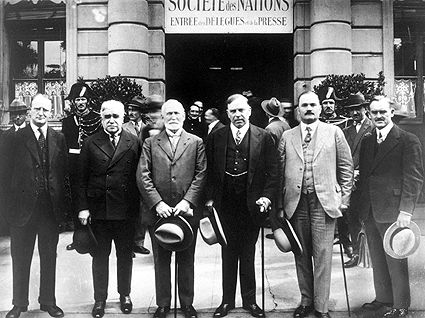
Treaty of Versailles
After the end of the First World War, the Paris Peace Conference of 1919 produced the Treaty of Versailles. The main authors of the Treaty were Britain (and its Dominions, including Canada), France and the United States. They believed that an international organization of countries could achieve and maintain collective security and peace. The Treaty of Versailles included a provision, or “Covenant,” for the creation of a League of Nations.
American President Woodrow Wilson played an important role in founding the League. But the United States Senate refused to ratify the Covenant of the League. This was partly due to American partisan politics. As a result, the US never joined the League. This deprived it of significant power and authority.
Sixty-three other states were members. The League established headquarters in Geneva, Switzerland. It included a council, assembly and secretariat. The council met quarterly. The major powers were permanent members. Non-permanent members were elected by the assembly. The assembly met annually and consisted of all member states. The secretariat provided the permanent staff under a secretary-general.
Canada’s Role
Canada was a founding member of the League. It served on the council from 1927 to 1930. From 1919 to 1926, Sir Herbert Ames served as financial director, a high administrative position in the secretariat.
In 1929, Raoul Dandurand, a Canadian representative on the council, made an important contribution. He successfully proposed strengthening the procedures by which the League oversaw the treatment of linguistic and religious minorities in eastern Europe.
In 1935, Canada supported the League’s sanctions against Italy. Canadian delegate Walter A. Riddell also proposed stopping all exports of oil, coal and steel to Italy. But this action was not approved by the new government of Prime Minister William Lyon Mackenzie King. It was publicly rejected.
Collective Security
The League allowed member states to discuss political and legal questions of international significance. These included disarmament, economic relations, the protection of minorities, communications, transit, and health and social issues.
Article 10 of the Covenant required member states to respect and preserve each other’s territory and independence. Aggression against any member would be considered aggression against all. It would lead to collective economic, and possibly military, measures. From 1920 to 1923, the Canadian government unsuccessfully sought to remove the League’s collective-security guarantees, fearing they would draw Canada into further European wars.
The purpose of collective security was to avoid war. In the 1920s, the League participated in the attempted reconciliation of Germany with France and Great Britain. However, these efforts failed in the face of the territorial aggression by Italy, Germany and Japan in the 1930s. The League’s social and economic activities continued until the Second World War. But by then the League had ceased to function as a collective-security organization. It was replaced by the United Nations in 1945.
Legacy
The League of Nations ultimately failed in its aim of collective security. However, it did establish a new model for international organizations. League membership brought Canada its first official contact with foreign governments and helped to establish its position as a sovereign state. It also introduced Canada to the opportunities and challenges of international co-operation and peacekeeping.
See also: League of Nations Society; NATO: Canada’s First Peacetime Military Alliance; Editorial: The Canadian Peacekeeping Tradition; Timeline: Peacekeeping.

 Share on Facebook
Share on Facebook Share on X
Share on X Share by Email
Share by Email Share on Google Classroom
Share on Google Classroom